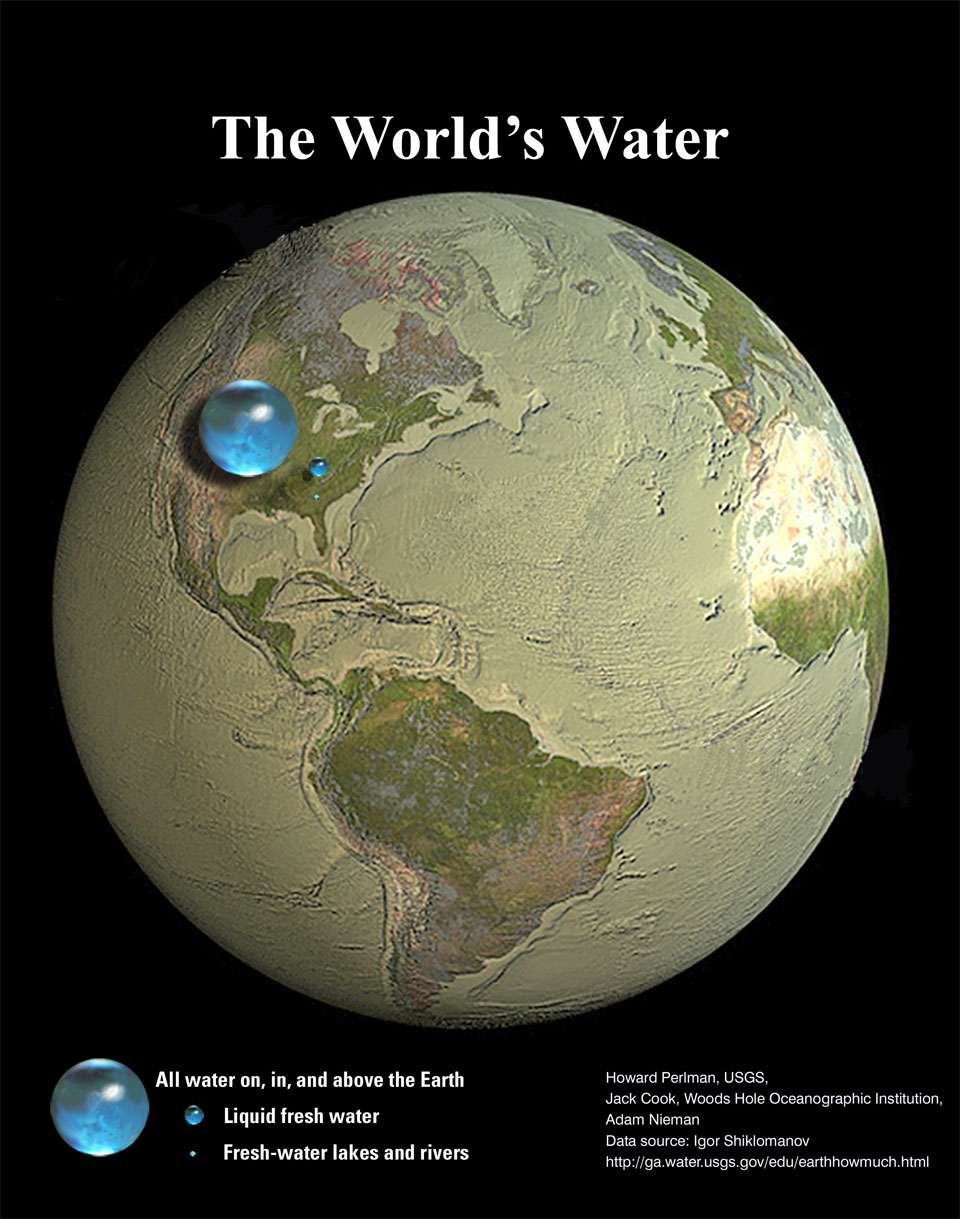26. September 2022
地球面頂 所有 ê 水

探索宇宙1!逐工會揀一幅無仝款 ê 影像抑是相片,𤆬你熟似咱這个迷人 ê 宇宙,閣有專業天文學者2為你3解說4。
- 原始文章:All the Water on Planet Earth
- 插圖來源:Jack Cook, Adam Nieman, Woods Hole Oceanographic Institution; 資料來源:Igor Shiklomanov
- 台文翻譯:An-Li Tsai (NCU)
[漢羅] 地球面頂 所有 ê 水
地球有偌濟成份是水? 實際上,足少--ê。 雖罔講 海洋 佔地球表面 70 葩,in kah 地球半徑比起來其實是 足淺--ê。 這張插圖 有畫予咱看,咱若是 kā 地球表面 kah 附近所有 ê 水,攏收集做一粒 水球,會變做啥款。 這粒水球 ê 半徑是干焦 700 公里爾爾,比咱 地球 ê 月娘 半徑 ê 一半閣較細。 毋閣是比土星 ê 月娘,土衛五 Rhea,較大淡薄仔。 Rhea kah 咱 太陽系 內底其他衛星仝款,主要是水冰組成--ê。 這粒大粒水球邊仔較細粒 ê 水球,是 地球 表面所有液態淡水。 上細粒 ê 水球,是地球表面 ê 淡水湖 kah 河川。 這寡 水 是按怎來到 地球--ê? 是毋是閣有大量水藏 tī 地表下底? 攏是咱欲研究 ê 主題。
[POJ] Tē-kiû bīn-téng só͘-ū ê chúi
Tē-kiû ū gōa-chōe seng-hûn sī chúi? Si̍t-chè siōng, chiok chió--ê. Sui-bóng kóng hái-iûⁿ chiàm Tē-kiû piáu-bīn 70 pha, in kah Tē-kiû pòaⁿ-kèng pí--khí-lâi kî-si̍t sī chiok chhián--ê. Chit tiuⁿ chhah-tô͘ ū ōe hō͘ lán khòaⁿ, lán nā-sī kā Tē-kiû piáu-bīn kah hū-kīn só͘-ū ê chúi, lóng siu-chi̍p chò chi̍t lia̍p chúi-kiû, ē piàn-chò siáⁿ-khoán. Chit lia̍p chúi-kiû ê pòaⁿ-kèng sī kan-na 700 kong-lí niā-niā, pí lán Tē-kiû ê goe̍h-niû pòaⁿ-kèng ê chi̍t-pòaⁿ koh khah sè. M̄-koh sī pí Thó͘-chhiⁿ ê goe̍h-niû, Thó͘-ūi-gō͘ Rhea, khah tōa, khah tōa tām-po̍h-á. Rhea kah lán Thài-iông-hē lāi-té kî-tha ūi-chhiⁿ kāng-khoán, chú-iàu sī chúi-peng cho͘-sêng--ê. Chit lia̍p tōa-lia̍p chúi-kiû piⁿ-á khah sè-lia̍p ê chúi-kiû, sī Tē-kiû piáu-bīn só͘-ū e̍k-thài tām-chúi. Siōng sè-lia̍p ê chúi-kiû, sī Tē-kiû piáu-bīn ê tām-chúi-ô͘ kah hô-chhoan. Chit kóa chúi sī án-ná lâi kàu Tē-kiû--ê? Sī-m̄-sī koh ū tōa-liōng chúi chhàng tī tē-piáu ē-té? Lóng sī lán beh gián-kiù ê chú-tê.
[KIP] Tē-kiû bīn-tíng sóo-ū ê tsuí
Tē-kiû ū guā-tsuē sing-hûn sī tsuí? Si̍t-tsè siōng, tsiok tsió--ê. Sui-bóng kóng hái-iûnn tsiàm Tē-kiû piáu-bīn 70 pha, in kah Tē-kiû puànn-kìng pí--khí-lâi kî-si̍t sī tsiok tshián--ê. Tsit tiunn tshah-tôo ū uē hōo lán khuànn, lán nā-sī kā Tē-kiû piáu-bīn kah hū-kīn sóo-ū ê tsuí, lóng siu-tsi̍p tsò tsi̍t lia̍p tsuí-kiû, ē piàn-tsò siánn-khuán. Tsit lia̍p tsuí-kiû ê puànn-kìng sī kan-na 700 kong-lí niā-niā, pí lán Tē-kiû ê gue̍h-niû puànn-kìng ê tsi̍t-puànn koh khah sè. M̄-koh sī pí Thóo-tshinn ê gue̍h-niû, Thóo-uī-gōo Rhea, khah tuā, khah tuā tām-po̍h-á. Rhea kah lán Thài-iông-hē lāi-té kî-tha uī-tshinn kāng-khuán, tsú-iàu sī tsuí-ping tsoo-sîng--ê. Tsit lia̍p tuā-lia̍p tsuí-kiû pinn-á khah sè-lia̍p ê tsuí-kiû, sī Tē-kiû piáu-bīn sóo-ū i̍k-thài tām-tsuí. Siōng sè-lia̍p ê tsuí-kiû, sī Tē-kiû piáu-bīn ê tām-tsuí-ôo kah hô-tshuan. Tsit kuá tsuí sī án-ná lâi kàu Tē-kiû--ê? Sī-m̄-sī koh ū tuā-liōng tsuí tshàng tī tē-piáu ē-té? Lóng sī lán beh gián-kiù ê tsú-tê.
[English] All the Water on Planet Earth
How much of planet Earth is made of water? Very little, actually. Although oceans of water cover about 70 percent of Earth's surface, these oceans are shallow compared to the Earth's radius. The featured illustration shows what would happen if all of the water on or near the surface of the Earth were bunched up into a ball. The radius of this ball would be only about 700 kilometers, less than half the radius of the Earth's Moon, but slightly larger than Saturn's moon Rhea which, like many moons in our outer Solar System, is mostly water ice. The next smallest ball depicts all of Earth's liquid fresh water, while the tiniest ball shows the volume of all of Earth's fresh-water lakes and rivers. How any of this water came to be on the Earth and whether any significant amount is trapped far beneath Earth's surface remain topics of research.
詞彙學習
| 漢羅 | POJ | KIP | 華語 | English |
|---|---|---|---|---|
| 土衛五 Rhea | Thó͘-ūi-gō͘ Rhea | Thóo-uī-gōo Rhea | 土衛五 | Rhea |
| 液態淡水 | e̍k-thài tām-chúi | i̍k-thài tām-tsuí | 液態淡水 | liquid fresh water |
| 半徑 | pòaⁿ-kèng | puànn-kìng | 半徑 | radius |